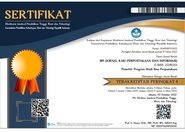GEN Z’S INFORMATION BEHAVIOR IN THE ERA OF AI: A STUDY APPLYING WILSON’S THEORY (CASE STUDY IN JAVA ISLAND)
Abstract
Keywords
Full Text:
PDFReferences
Al-Suqri, M. N., & Al-Aufi, A. S. (2015). Information Seeking Behavior and Technology Adoption.
A’yun, M. Q. (2025). Memahami Generasi Z: Tantangan, Perilaku, dan Peluang. BPS Kabupaten Gorontalo. https://gorontalokab.bps.go.id/id/news/2025/02/05/30/memahami-generasi-z--tantangan--perilaku--dan-peluang.html
Babbie, E. R. (2021). The practice of social research (15th ed.). Cengage Learning Custom Publishing.
Badan Pusat Statistik. (2020). Jumlah Penduduk menurut Wilayah, Klasifikasi Generasi, dan Jenis Kelamin, Indonesia, Tahun 2020. http://sensus.bps.go.id/topik/tabular/sp2020/2?share=1
Caesarani, E. E., & Suharso, P. (2024). Perilaku Informasi Generasi Z Melalui Akun Autobase Kuliner dalam Media Sosial X. ANUVA, 8(2), 227–240.
Case, D. O. (2007). Looking for information: A survey of research on information seeking, needs, and behavior (2nd ed). Elsevier/Academic Press.
Clark, A. (2008). Supersizing the mind: Embodiment, action, and cognitive extension. Oxford Univ. Press.
Das, A. K., & Mandal, S. (2021). User Information needs and Information Seeking Behaviour of Physics Department at the University of Burdwan. Library Philosophy and Practice, 0_1,1-25.
De Spiegeleire, S., Maas, M., & Sweijs, T. (2017). Artificial Intelligence and the Future of Defense: Strategic Implications for Small- and Medium-Sized Force Providers. He Hague Centre for Strategic Studies. http://www.jstor.com/stable/resrep12564.7
Erdelez, S. (1995). Information encountering: An exploration beyond information seeking [Syracuse University]. https://surface.syr.edu/it_etd/38
Febriana, AD & Syam, AM. (2025). Enhancing student visits through library strategies: A case study of SMKN 1 Percut Sei Tuan. Informatio: Journal of Library and Information Science 5 (3), 238-250
Ghozali, G. (2016). Aplikasi Analisis Multivariete Dengan Program IBM SPSS. Badan Penerbit Universitas Diponegoro.
Hirvonen, N., Jylhä, V., Lao, Y., & Larsson, S. (2024). Artificial intelligence in the information ecosystem: Affordances for everyday information seeking. Journal of the Association for Information Science and Technology, 75(10), 1152–1165. https://doi.org/10.1002/asi.24860
Hu, A., & Ou, M. (2025). From passive to active: How does algorithm awareness affect users’ news seeking behavior on digital platforms. Telematics and Informatics, 100, 102291. https://doi.org/10.1016/j.tele.2025.102291
Izzati, D. R. (2025). Information Search Behavior Of International Special Collections At The University Of Indonesia Library. 10(1). https://jurnal.uinsu.ac.id/index.php/jipi/article/view/22665/10004
Kemp, S. (2025). Digital 2025; Indonesia. Datareportal. https://datareportal.com/reports/digital-2025-indonesia
Khairifa, F., Kholil, S., Syam, AM & Mujtahid, NM. (2025). Mitigating food waste and household waste management: The potential for redistributing surplus food in the policy communication of Medan City government. IOP Conference Series: Earth and Environmental Science 1445 (1), 012047
Komara, D. A., & Widjaya, S. N. (2024). Memahami Perilaku Informasi Gen-Z dan Strategi Melawan Disinformasi: Sebuah Tinjauan Literatur Penggunaan Media Sosial. Jurnal Pustaka Ilmiah, 10(2), 155. https://doi.org/10.20961/jpi.v10i2.85775
Li, Y., Ring, J. K., Jin, D., & Bajaba, S. (2025). Elevating entrepreneurship with generative artificial intelligence. Journal of Innovation & Knowledge, 10(6), 100820. https://doi.org/10.1016/j.jik.2025.100820
Maceviciute, E. (2025). Information management according to Professor Wilson. Information Research an International Electronic Journal, 30(2), 39–64. https://doi.org/10.47989/ir30253981
Marjerison, R. K., Jun, J. Y., & Kim, J. M. (2025). Socio-Technical Antecedents of Social Entrepreneurial Intention: The Impact of Generational Differences, Artificial Intelligence Familiarity, and Social Proximity. Systems, 13(7), 616. https://doi.org/10.3390/systems13070616
Masrek , M. N. ., Baharuddin , M. F. ., & Syam , A. M. . (2025). Determinants of Behavioral Intention to Use Generative AI: The Role of Trust, Personal Innovativeness, and UTAUT II Factors. International Journal of Basic and Applied Sciences, 14(4), 378-390. https://doi.org/10.14419/44tk8615
Mumtazien, G & Syam, AM. (2024). Peran Perpustakaan Sekolah dalam Meningkatkan Literasi Membaca Siswa. Reslaj: Religion Education Social Laa Roiba Journal 6 (11), 5782–5793
Norman, D. A. (2013). The Design of Everyday Things (Rev. and expanded edition). MIT press.
Pariser, E. (2011). The Filter Bubbble: What the Internet is Hiding from You. Penguin Press.
Ruan, Q. (2025). A philosophical perspective on constructing an information literacy education framework to foster college students’ complex thinking skills. Humanities and Social Sciences Communications, 12(1), 1409. https://doi.org/10.1057/s41599-025-05760-5
Russell, S. J., & Norvig, P. (with Chang, M., Devlin, J., Dragan, A., Forsyth, D., Goodfellow, I., Malik, J., Mansinghka, V., Pearl, J., & Wooldridge, M. J.). (2022). Artificial Intelligence: A Modern Approach (Fourth edition, global edition). Pearson.
Ritonga, A. R., Education, I. R., Zein, A., Syam, A. M., & Ohorella, N. R. (2023). Misconceptions of Jihad: A Constructivist Review of the Meaning of Struggle in Islam in the Modern Era: Analysis of the verses al-Amwaal wa al-Nafs.
Sayekti, R., Batubara, A. K., Aditya, M., Purwaningtyas, F., & Syam, A. M. (2021). When the" Library as Place" Matters: A Case Study of an Academic Library. Library Philosophy & Practice.
Sekar Arum, L., Amira Zahrani, & Duha, N. A. (2023). Karakteristik Generasi Z dan Kesiapannya dalam Menghadapi Bonus Demografi 2030. Accounting Student Research Journal, 2(1), 59–72. https://doi.org/10.62108/asrj.v2i1.5812
St. Jean, B., Gorham, U., & Bonsignore, E. (2021). Understanding human information behavior: When, how, and why people interact with information. Rowman & Littlefield.
Sun, H., & Adnan, H. M. (2025). Exploring the Differences in Information Encountering Among Young Users of Mobile Social Media in China Under Different Moods. Studies in Media and Communication, 13(3), 111. https://doi.org/10.11114/smc.v13i3.7582
Wang, X., Wuji, S., Li, M., Liu, Y., & Luo, R. (2026). Social impact of recommendation algorithm in crisis: Forming algorithmic experience through group information interaction and algorithm task fit. Information Processing & Management, 63(1), 104323. https://doi.org/10.1016/j.ipm.2025.104323
Wardi, R. H., Hassan, M. H., Mohd Yusof, U. Z., & Rosman, R. (2025). Gen Z’s Learning Preferences In Creative Design: A Conceptual Framework. Quantum Journal of Social Sciences and Humanities, 6(3), 332–343. https://doi.org/10.55197/qjssh.v6i3.771
Widiyastuti, W. (2016). Perbandingan Teori Perilaku Pencarian Informasi Menurut Ellis, Wilson Dan Kuhlthau. Jurnal Pustaka Budaya, 3(2), 51–64.
Wulandari, DA & Syam, AM. (2025). Analysis of The Availability of Braille Collections at The Public Library of Deli Serdang Regency Based on The Needs of The Visually Impaired. LITERACY: International Scientific Journals of Social, Education, Humanities 3 (3), 76-82
DOI: http://dx.doi.org/10.30829/jipi.v10i2.25964
Refbacks
- There are currently no refbacks.
Copyright (c) 2025 Aam Mariyamah, Majidah Majidah

This work is licensed under a Creative Commons Attribution-ShareAlike 4.0 International License.










.png)

